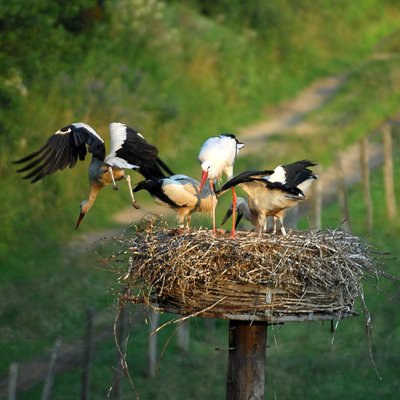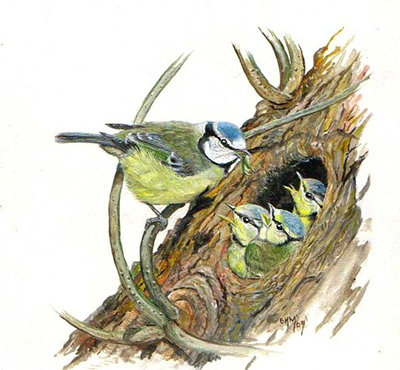The Builders of the World
In this sunny spring, nature unfolds all its beauty in unison,
When we look at the mountains and hills surrounding Saint-Girons,
We think of the soft frieze of springs and waterfalls gurgling under the foliage,
The razor-sharp thorns of wild blackthorns hanging mercilessly on our pants.

The mountains partly stripped of their snow,
sparkle with light under an immaculate blue,
We can imagine the resounding paths of barking and clarines near the shepherds' huts,
Close to the bivouac overlooking on a tiny terrace a lake still darkened by dawn,
Set in a fairyland of steep walls blushing by the shy shining glow of the rejuvenated sun.

All is silence, nature wakes up by magic, happy,
The birds perform multiple pirouettes accompanied by happy trills,
And if their song did not only accompany the nests in the making,
What if it was also a tiny effort for a rebuilding world?
These winged companions have always fascinated me from the hoopoe to the chimney swallows,
Every year in early spring I observe the flurry of winged nesting,
I am more amazed than ever to see these birds with a twig in their beak,
Some of them are my favorites for their high-tech architectural choices.

Magpies for example, the "agassos" in Ariège dialect, skillfully shape their nest,
Assembly of entangled twigs with a roof made of thorny branches only,
Supposed to protect eggs and future broods from predators, crows or hawks in tow,
The couple builds several nests, those in inverted pyramid without roof, for recourse!

The great spotted woodpecker with the black, short and powerful bill finds its shelter every year, goddamn it,
Magnificent bird with black and white plumage matched with a red spot on the lower abdomen,
His house, carved out of an old trunk, is lined with feathers and dry grass,
The female broods during the day, the male takes care of the brooding every cool night.

Same attachment for the hoopoes, with their red crest open in a fan,
Its long, thin and curved beak allows this burrower to capture worms for feast,
Its song is summed up in three repetitive vocalic sounds, houp-oup-oup,
To nest, she uses hollow trees or woodpecker lodges, a scoup!

As for the buzzards building a thick nest at the fork of the top of an oak tree, strange,
I remember the fate of the peasants who nailed them to the barn doors,
In repression of their capture of hens or young rabbits after their circular flight,
Sowing panic in the backyards of the old sharecroppers.

The beginning of spring marks the return of the gray cuckoo in our regions,
Where we can hear its characteristic cry, during this breeding season,
This famous "neck-neck", pushed by the males to attract the haughty females,
So that the lady can lay eggs, but in a very unique way.
This species does not build its own nest, but it does nest another,
She spots a nest with eggs and waits for the female to leave for the spur field,
She will then fly to this nest and lay her egg, after swallowing one,
This is brood parasitism, the host pair incubates the common, intruding egg.

The abused mother replaces the cuckoo lady and feeds the baby after hatching,
The young are born two days before those with whom they share the nest, future chicks,
Instinctively he will throw the eggs out of the nest, using his hollow spoon-shaped back,
By carrying out this mischief, the gray cuckoo will have all the necessary food to grow!

With his pale heart-shaped face mask, surrounding his puppet eyes,
The barn owl is easy to recognize, a splendid little owl,
The upperparts are gray and russet, finely mottled white and black,
The lower ones are a tint of pure white dotted with pronounced reddish spots.
The barn owl is cave dwelling, it seeks a cavity to make its nest,
Settling on the site in February and March where courtship displays are increasing,
The theft of the male is embellished with loud sexual pursuits and offerings,
The female lands on the substrate creating a small bowl, receiving the reverend egg.

Emblematic of Alsace, where they instinctively build their nest on the chimneys,
White storks with black and white plumage on their long red legs perched,
Collect branches with which they build their nests with affection,
The male adds new materials every year for gigantic constructions.
During the nuptial period the partners greet each other by clicking their beaks, head thrown back on the back,
The storks clatter or gloat like distant shots from commando machine guns,
When the agreement is successful, displays and caresses, precede the acrobatic coupling,
Male and female take turns for brooding for around 40 phlegmatic days.

« "I have spring at the end of my wings and bring you new flowers»,
Known as the Chimney Swallow or Barn Swallow, it chirps in the sky,
It is distinguished by its brick red throat and its long forked tail,
Its nest of dried earth is often hung under a roof or a worm-eaten beam.
More than 100 trips to assemble the little mudballs have been made
Once the work is finished, it will be filled with chicken feathers and cozy down,
After hatching, 400 times a day the parents bring insects to the mischievous chicks,
Who, 20 days later, will leave the nest with their joyful cries rising to the heavens.

The Blue Tit gets its name from the blue of its crown, wings and tail,
His very diverse vocal repertoire makes him utter very shrill cries, "tsi-" tsi ",
Cavernicolous breeder, it builds in any cavity with restricted entry for its nest,
She broods, he takes care of supplies, the flight occurs after twenty fluffy days.
Guy dit l’Arié…..Joie
